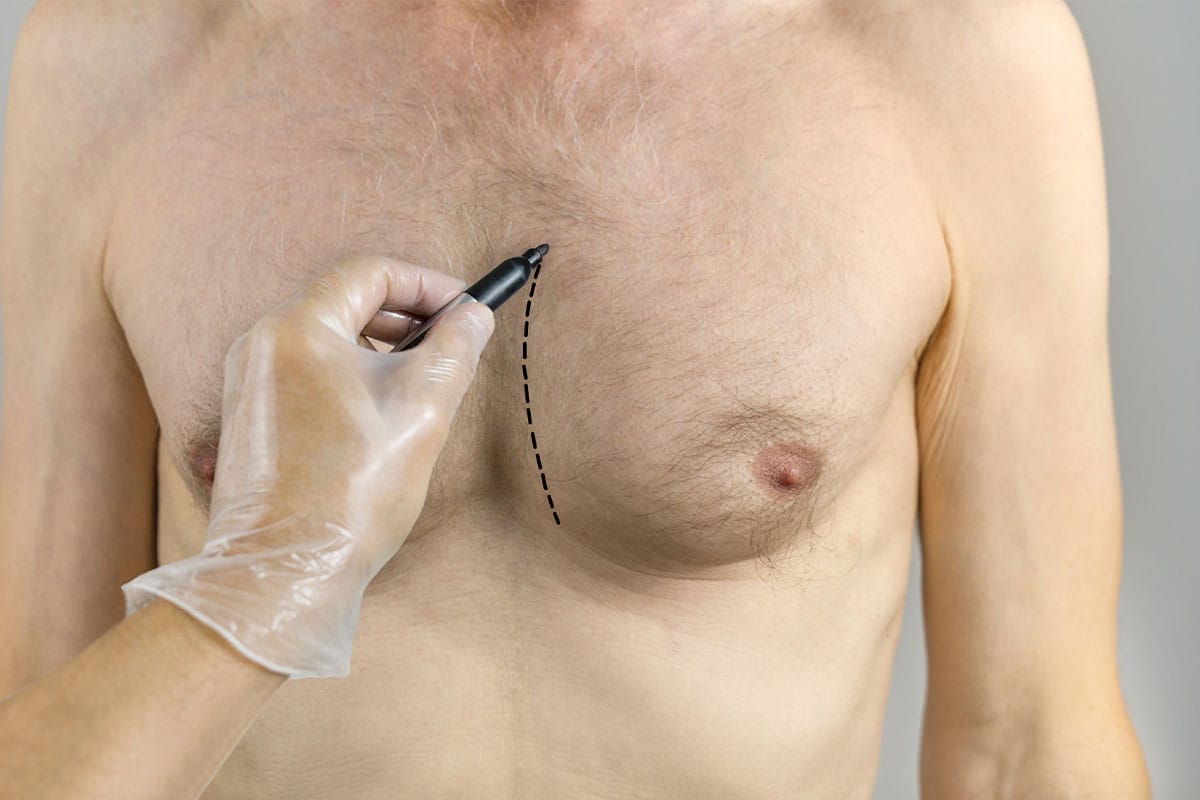I was mid-marking a chest with my coffee getting cold on the counter, the afternoon light slanting through the blinds and the sound of rain against the windows at 823 Campbell Hill Street NW, near the Square. This past Tuesday, you sat on the stool in front of me, shoulders tense, shirt folded into a precise square on your lap. I traced along the edge of the areola, paused, and asked you to lift your arms so I could watch how the tissue moved. You exhaled like you’d been holding your breath for years. I get it. I remember being a resident, palms sweaty, learning exactly where to make that crescent incision so the line hides in the color change. Now it’s second nature, but the weight of the moment never is. I told you I’d be honest about what surgery can and can’t do. You nodded once, eyes wet, and said you just wanted to feel normal at the pool again. Outside, traffic hummed on 75, and my pager buzzed; between moments like this, I remember why I chose this work today. For many men, gynecomastia surgery procedures are about confidence, not vanity.
What You Need to Know First
When you sit with me for a gynecomastia evaluation, I start with your story: when you noticed the change, what makes it worse, what helps. I look, I palpate, and I watch how the tissue behaves when you tense your chest. Most people don’t expect me to say the word “gland” so often, but the difference between dense breast tissue and soft fat determines the plan. If I feel a rubbery disk under the areola, I plan a small periareolar excision; if it’s mostly fat, I plan liposuction through 3–4 mm openings along the chest fold.

Digging Into Underlying Causes
My nurse Michelle always reminds me to slow down and ask about habits that quietly fuel the problem: supplements, testosterone, marijuana, certain antidepressants, even heartburn meds. I don’t judge; I just want to know what I’m operating against. Sometimes the cause is puberty that never fully settled; sometimes it’s weight changes. Sometimes it stays mysterious, and that uncertainty is hard for both of us. I say that out loud because pretending otherwise helps no one.
I also check skin quality. If you’ve got good snap-back, I can avoid extra scars; if your skin is lax, I may need to tighten it, or accept that a vest and patience will do the work. I measure your areola, chest width, and asymmetries. I take photos so you and I can agree on where we’re starting. I’m meticulous, but I’m also realistic. In Marietta, GA, people live in T‑shirts and heat, and little details like vest comfort and incision placement matter.
What Gynecomastia Surgery Can and Can’t Do
Gynecomastia surgery is not a fix for gym avoidance or diet lapses. It’s a contouring procedure that sharpens what you’ve already built or sets a clean slate if tissue won’t budge. I’ll talk to you about smoking, blood thinners, and timing around work or school. If labs or imaging are needed, I order them. If you’re not ready, I say so. I tell my staff I’m probably too honest with patients, and I stand by that. I also walk you through risks—bleeding, contour irregularities, numb nipples, fluid collections—and how I prevent them and fix them if they happen. I won’t promise perfection, but I will promise a plan, close follow‑up, and clear instructions you can actually follow after a long day.
The Real Story
When surgery day arrives, I meet you in pre‑op and redraw the plan on your chest while you go over last‑minute questions. In the OR, anesthesia keeps you safe and comfortable; most of my gynecomastia cases are under general, though select liposuction‑only cases can be done with deep sedation. I infiltrate numbing fluid to cut down bleeding and pain, then I sculpt with power‑assisted liposuction to feather the edges so the chest doesn’t look scooped. In practical terms, most gynecomastia surgery procedures combine liposuction and targeted excision to balance the chest.
Techniques for Gland and Skin
If I can pinch a firm glandular core under the areola, I make a half‑moon incision at the color change and remove the dense disk under direct vision. I’m careful to leave a thin, even layer so the nipple doesn’t sink. Some call it gyno removal. Sometimes I add internal stitches to tack the skin to the muscle for a clean contour. If the skin is lax or the areola too large, I reduce it a few millimeters so proportions make sense with your frame.
Immediate Recovery and Dressings
I place dissolving sutures and a small dressing. I rarely use drains; if I do, it’s because the gland was huge or the pockets needed it. You wake up with a compression vest that you’ll wear for several weeks. In recovery, I check symmetry, make sure the nipples are perfusing, and I talk to you and the person driving you home about the evening plan: rest, ice packs on and off, short walks, and meds on schedule.
Last spring, I treated a college pitcher who’d hidden under hoodies for years. He messaged me a month later saying he finally ran without crossing his arms. Right before the holidays, I see a rush of men who want to reset before family photos and New Year’s pools in Florida. Between those seasonal waves, between surgeries, I sometimes grab lunch at Taqueria Tsunami on the Square and watch crews set up for Marietta Square events. Those moments remind me that this isn’t vanity; it’s permission to participate.
Setting Realistic Expectations for Healing
I don’t airbrush the reality: swelling is normal, bruises are normal, weird ripples for a few weeks are normal. What isn’t normal is sharp worsening pain, sudden size change, fever, or dusky nipples. If anything worries you, you call me—day or night. I pick up fast, and I would rather overreact than miss trouble for you always.
Making It Work
I focus hard on the first two weeks after a gynecomastia procedure. The vest stays on full‑time except for quick showers, and I want you walking several times a day to keep your lungs clear and your legs moving. I see you in the office at 823 Campbell Hill Street NW, near the Square, for dressing changes and photos so we can track how swelling shifts.
Activity Guidelines and Restrictions
Sleeping on your back with a slight incline helps; side sleeping sneaks back in after about two weeks. Arms overhead? Light only in week one, full range by week three, and pressing or push‑ups no sooner than four to six weeks. I know that downtime is frustrating. I lift too, and I hate losing momentum. But scar tissue remodels on its own schedule, not mine or yours, and pushing early can leave dents that take months to smooth.

Massage is gentle and brief, starting around day seven if the skin looks right. Silicone sheets or gel go on once incisions are sealed. Sun is the enemy of scars, especially here in Marietta, GA, where the Georgia heat convinces everyone to take off shirts by April. Cover the area or use high‑SPF sunscreen for a full year. It sounds fussy; it’s worth it.
Pain Management and Comfort Tips
Pain is usually soreness, not agony. I use long‑acting local anesthetic during surgery, stagger anti‑inflammatories with acetaminophen, and save the stronger pills for sleep if needed. Constipation happens, so I set you up with a stool softener from day one. If you’re queasy, I have a plan for that too.
Money, Time, and Logistics
Money and time matter. Insurance rarely helps, and I say that plainly. I build quotes that include the facility, anesthesia, and my fee, and I outline exactly what’s optional. If spacing payments or picking a slower season helps, say so; I can usually adjust dates. Traffic on 75 can turn a ten‑minute drive into thirty, so I schedule your early visits with buffer time. If you come in from out of town, I want you nearby for forty‑eight hours, then reachable by phone or video for the next two weeks. I can’t control every variable, but I can stay close and keep you moving forward. If something feels off, send a photo, call, or walk in, no apology needed ever.
Where to Go From Here
I believe the best consult for gynecomastia surgery feels like a working session, not a sales pitch. Bring your questions, bring a list of meds and supplements, and bring photos of what bothers you in different shirts. I’ll take standardized pictures, draw on your chest with a mirror, and map out a sequence that fits your life.
Preparing for Surgery and Recovery
If you want to move forward, we pick a date and I give you a written plan that covers labs, meds to stop, what to buy, when to start showering, and how to set up a comfortable recovery corner at home. I’ll also give you pre‑op nutrition and sleep tips; healing loves routine. If you’re on a fitness program, we’ll time surgery so you’re not missing something you’ve trained months to hit.
If you’re not ready, that’s fine. I’d rather you pause than commit because the anxiety felt louder than the benefit. I can point you toward counseling or an endocrinology check if something in your history suggests it. Sometimes the hardest part is saying the goal out loud; once you do, the rest becomes a series of logistics.
I run on time, but I’m human. If rain backs up the city or an earlier case demands extra minutes, I’ll tell you. I’ve waited for good light to take a scar photo because I wanted you to see the truth, not a blur. That small patience matters more to long‑term satisfaction than any fancy tool in the OR.
Open Door and Flexible Scheduling
You’re welcome to swing by for a quick look at vests and scar gels even before committing. My door stays open, and my inbox is faster than voicemail. I’ll meet you at the office, walk you through the space, and let you decide. When you’re ready, I’m ready. Walk in after work, or schedule a morning before the Square wakes; I’ll make space, pour fresh coffee, and set expectations that feel doable for your schedule and the people who depend on you.
Frequently Asked Questions
How long until I can take my shirt off at the pool?
I tell you to plan on three weeks for the bruises to fade and six to eight weeks for swelling to settle enough that casual eyes don’t notice. The vest comes off gradually after two to three weeks, and light cardio starts early. Lifting returns in stages. If healing hiccups, I add visits. I’d rather slow down than rush and regret a contour blip that needed patience.
Can gynecomastia come back after surgery?
If I remove the gland and contour the fat well, recurrence is uncommon. That said, hormones, significant weight gain, certain meds, and steroids can stimulate new growth. I don’t police your choices; I explain cause and effect. If something changes—new meds, new symptoms—we talk. I’ve done touch‑up liposuction for weight shifts and tiny revisions for a stubborn ridge. I own the plan with you, and I won’t disappear once the last stitch dissolves.
What will my scars and nipple sensation be like?
I hide the incision along the areola’s edge, so most people miss it unless they’re inches away. Early scars look pink; over months, they fade to a fine line. Nipple sensation usually returns, but it can feel weird—itchy, electric, numb, then normal. I tell you that up front because surprises erode trust. If sensation stays reduced at six months, I show you desensitization tricks and time; nerves regrow over time. For more information about gynecomastia surgery, you can explore detailed discussions and patient experiences. Contact us today to learn more about our professional services.

Written by: Dr. Atanu Biswas
Board-Certified Plastic Surgeon, Marietta Plastic Surgery
About Dr. Biswas




